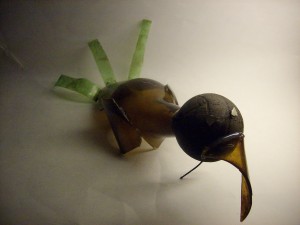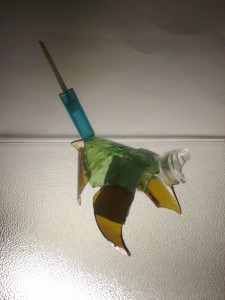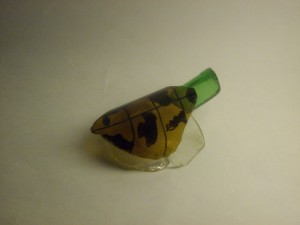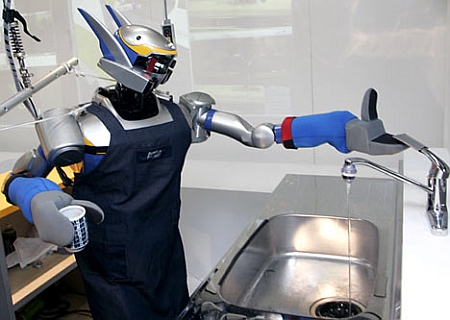Glass Creatures from my Creek
January 11th, 2009 Posted in cleaning, green living, projects, reusing, water | No Comments » Make sure you like EcoJoes on Facebook to stay updated on green ways to save money and help the environment. Just click the "like" button below. Muchas gracias!
Deep in the sprawling Peck Estates there is a meandering brook, full of plants, wildlife, and brisk, babbling water. Whenever I grow weary of my toils to better this planet called Earth, I cast my eyes upon this creek, and tears of wonder carve clean trails down my dusty face.
But it’s not “all good in the hood”, as Mister Rogers would say. Over the last month or so, I’ve cleaned out a LOT of litter just from my small part of the creek. The litter has ranged in size from tiny shards of broken glass to a metal chair to a freaking stop sign.
After cleaning all that mess out, me and Tiff decided to make some creek animals out of the junk, since all the trash had come from the creek. What follows may shock and even horrify you. Prepare to look upon the creek creatures.
CLICK THE PICTURES TO SEE A BIGGER PICTURE
Glassy the Turtle
Turkey Thing
Made from a gen-u-ine 40 bottle (and maybe an old racquetball?).

Glass Frog
If you use your imagination, this pile of reused glass might look remotely like a frog.

Simple Snail
Another Tiff creation. My blurry picture does not do this glass snail justice.

Parrot with Coke Bottle Body
Snake made from Broken Glass
That’s his tongue on the left.

Glass Hell Monkey
Its tail is made from a LipSmackers brush. He is one menacing mamma jamma.

We recycled all the leftover broken glass and old cans and bottles. All in all, it was a good way to reuse some litter, and make some “art” from it. If anyone else has done cleaned up litter from a creek or stream and made something from it, por favor let me know!



 Until today, it’s been illegal for North Carolinians to water their lawns with gray water. But it looks like the extended drought and water restrictions have been enough to change lawmakers’ minds. According to the
Until today, it’s been illegal for North Carolinians to water their lawns with gray water. But it looks like the extended drought and water restrictions have been enough to change lawmakers’ minds. According to the 
 Here in North Carolina we’re in the midst of a good ol’ drought. As my backyard slowly turns into desert, I wonder if there’s a way to clean my car without using water.
Here in North Carolina we’re in the midst of a good ol’ drought. As my backyard slowly turns into desert, I wonder if there’s a way to clean my car without using water. Arsenic in water is a big problem in the developing world. It can cause death within 30 minutes. Worse, it is usually odorless and flavorless, so it’s hard for people to detect. Luckily,
Arsenic in water is a big problem in the developing world. It can cause death within 30 minutes. Worse, it is usually odorless and flavorless, so it’s hard for people to detect. Luckily,  Dr. Colvin’s arsenic magnet system could go global as soon as the next five years (if it passes governmental regulations). If her arsenic magnet is mass-produced, it could ease water (and arsenic) worries for millions of people in the developing world. For her invention, I have decided to award her the prestigious EcoJoes
Dr. Colvin’s arsenic magnet system could go global as soon as the next five years (if it passes governmental regulations). If her arsenic magnet is mass-produced, it could ease water (and arsenic) worries for millions of people in the developing world. For her invention, I have decided to award her the prestigious EcoJoes  Let’s say you’re about to clean your dishes, and you want to do it in the best way environmentally possible. So do you use your energy-efficient dishwasher, or do wash your dishes by hand? It might seem like a simple question, but man oh man there are a lot of answers (and a lot of other websites which have covered this question, with one result or the other). I’ll try to look at both sides of this surprisingly heated debate.
Let’s say you’re about to clean your dishes, and you want to do it in the best way environmentally possible. So do you use your energy-efficient dishwasher, or do wash your dishes by hand? It might seem like a simple question, but man oh man there are a lot of answers (and a lot of other websites which have covered this question, with one result or the other). I’ll try to look at both sides of this surprisingly heated debate.